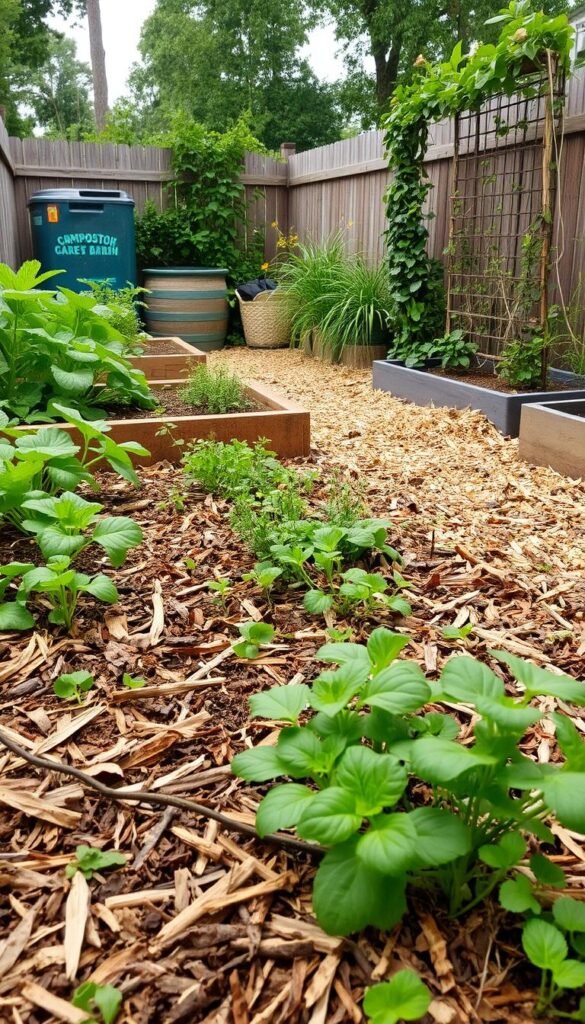Ever wonder how to keep your vegetable patch thriving while saving water and time? Covering soil with natural materials isn’t just for large farms. Even compact urban gardens can benefit from this age-old technique.
By adding a protective layer around your plants, you lock in moisture and suppress weeds naturally. Organic options like shredded leaves or grass clippings break down over time, feeding your soil with nutrients. Research from the USDA shows this approach can improve plant growth by up to 30% compared to bare earth.
We’ll explore practical ways to use compost, straw, and other biodegradable materials in tight spaces. These solutions help conserve water during dry spells and create healthier roots for tomatoes, herbs, and other favorites. Best part? You’re repurposing yard waste instead of tossing it.
Whether you’re growing on a balcony or in raised beds, our science-backed tips adapt easily. Let’s dive into strategies that make your green space more resilient – and a little kinder to the planet.
Understanding the Benefits of Organic Mulching
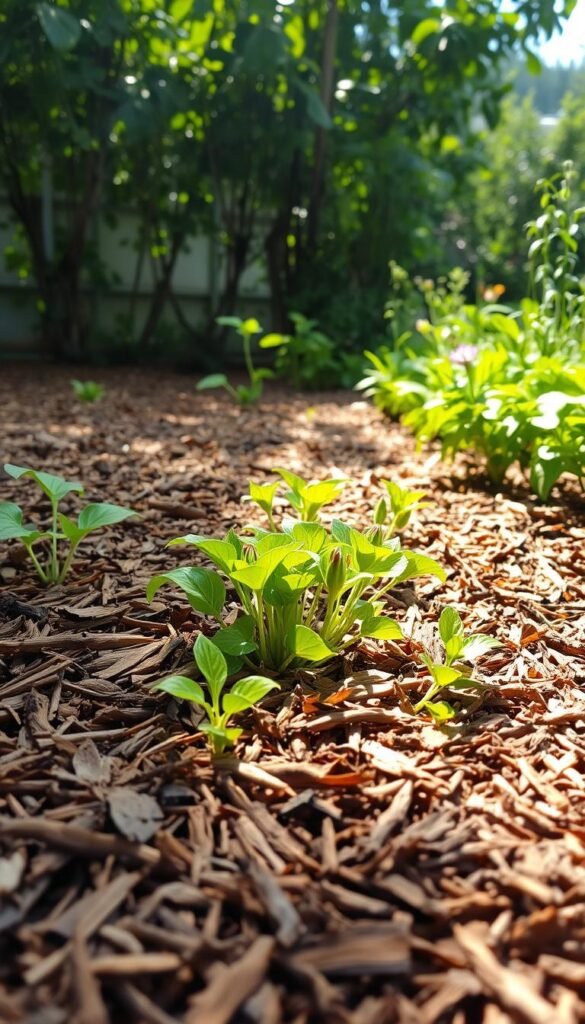
What if a single change could cut your watering chores and boost plant health? Organic layers act like a sponge and shield for your garden, offering multiple science-backed advantages. Let’s unpack why this natural approach works so well.
Retaining Water While Feeding Your Soil
Straw mulch reduces evaporation by 35%, according to agricultural studies. This protective barrier slows water loss on hot days, meaning you’ll refill that watering can less often. During the Dust Bowl era, farmers discovered mulched plots survived droughts better than exposed soil.
As organic materials break down, they release nitrogen and potassium into the earth. Think of it as a slow-release fertilizer – your tomatoes get steady meals instead of sudden nutrient spikes. Healthier roots develop when moisture levels stay consistent.
Blocking Weeds Without Chemicals
Sunlight can’t reach weed seeds through a 3-inch mulch layer. USDA research shows this simple trick slashes unwanted plant growth by up to 80%. Fewer weeds mean less back-breaking pulling and no toxic sprays near your kale.
Heavy rains? Mulch acts like Velcro for soil. Environmental reports confirm it reduces erosion by 60% compared to bare ground. Your precious topsoil – and the compost you worked into it – stays put instead of washing away.
Real-world tests in community gardens prove these benefits. One Minnesota project saw pepper yields jump 40% after switching to leaf-based mulches. Your plants get hydration, nutrition, and protection – all from materials you might already have.
Eco-Friendly Mulching Methods for Small Space Plots
Your tiny garden has big potential when paired with the right ground cover. Sustainable layers do more than just suppress weeds – they create thriving ecosystems where plant roots flourish. Let’s uncover why this approach transforms limited growing areas.
Nourishing Roots in Confined Areas
Compact gardens need soil that works smarter. Organic mulch like shredded bark or compost breaks down gradually, releasing nutrients directly to your plants. University studies reveal this process increases microbial activity by 45%, creating a living network beneath the surface.
Water conservation becomes critical in raised beds or containers. A 2-inch layer of organic materials cuts irrigation needs by half during summer months. Your basil and peppers stay hydrated longer between waterings, even in window boxes.
Urban gardeners report fewer pest issues when using natural mulches. Coffee grounds repel slugs, while cocoa bean shells deter curious squirrels. These solutions protect delicate growth without harsh chemicals.
Try mixing grass clippings with fallen leaves for a nutrient-packed blend. Community gardens in Portland saw tomato yields double after adopting this method. Your small plot can achieve similar results – healthier plants and richer harvests.
Exploring a Variety of Organic Mulch Options
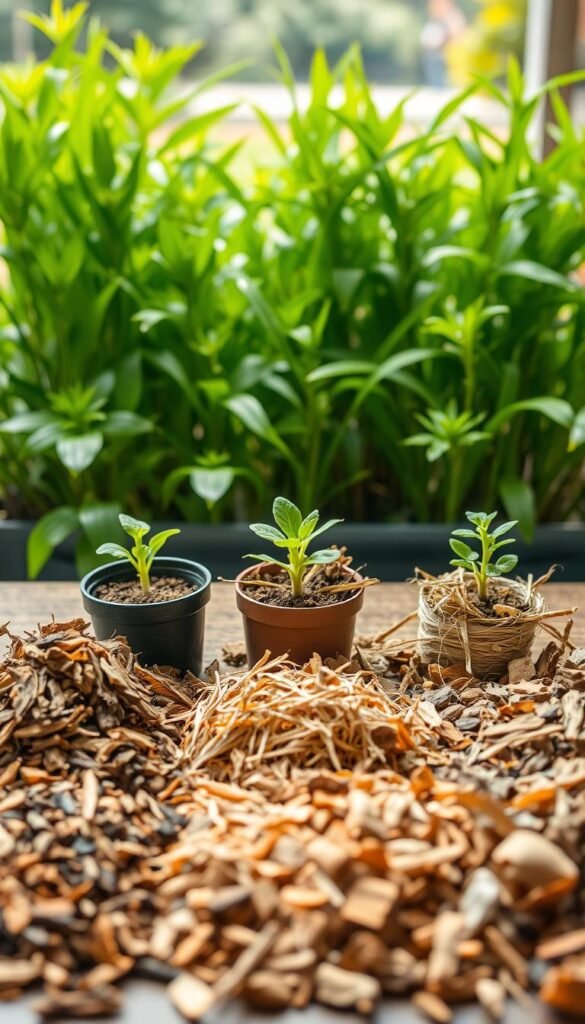
Your garden’s success starts from the ground up – literally. Choosing the right protective layer can transform your soil’s health while simplifying maintenance. Let’s break down nature’s best options for nourishing plants and conserving resources.
Grass Clippings, Leaves, and Composts
Grass clippings release nitrogen as they decompose, giving plants an instant boost. Fresh cuttings work best when spread thinly to prevent matting. Mix them with fallen leaves for balanced nutrition – this combo adds organic matter while improving drainage.
Leaf mold (decomposed leaves) increases soil’s water-holding capacity by 50%, according to University of Cape Coast research. Shredded leaves break down faster, feeding earthworms and beneficial fungi. For heavy feeders like tomatoes, compost delivers 2% nitrogen and 1% phosphorus – perfect for hungry roots.
Wood Chips and Straw Mulch Advantages
Wood chips excel in long-term moisture retention, reducing watering needs by 30% compared to bare soil. They stabilize soil temperature year-round, protecting roots from summer heat and winter chills. A 3-inch layer lasts up to two years, making them ideal for perennial beds.
Straw mulch shines in vegetable plots, especially when using no-dig gardening methods. Untreated straw suppresses weeds while letting water penetrate easily. Source organic bales to avoid herbicide residues – your zucchini and beans will thank you.
Both options improve soil structure over time. Rotting wood chips attract carbon-loving microbes, while straw decomposes into silky humus. Match your choice to your plants’ needs: quick nutrients for annuals, lasting coverage for shrubs.
Implementing Mulching in Your Vegetable Garden
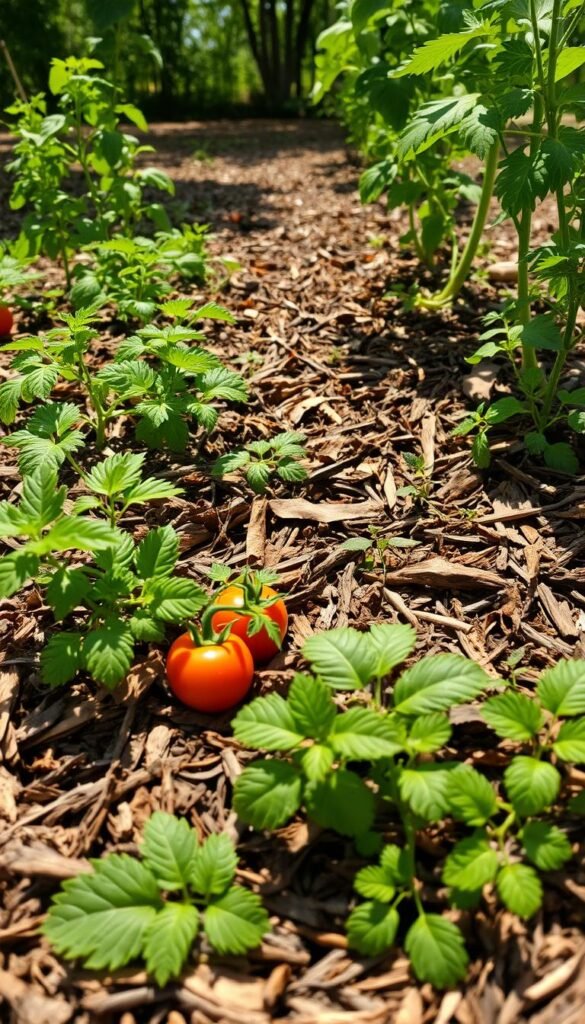
Transform your veggie patch into a powerhouse of productivity with smart mulching strategies. A well-timed organic layer does more than suppress weeds—it becomes your garden’s secret weapon for thriving crops. Let’s break down how to apply these techniques for maximum impact.
Improving Soil Health for Vibrant Growth
Healthy soil grows healthy food. Organic mulches like compost or shredded leaves release nutrients slowly, feeding your plants’ roots all season. University studies show gardens using compost-enriched mulch see 25% higher nutrient levels in tomatoes and peppers.
Apply a 2-inch layer after seedlings establish themselves. This protects tender roots from temperature swings while letting rainwater penetrate. Over time, earthworms mix the decomposing material into the earth, creating a living soil ecosystem.
Balancing Organic Matter and Water Retention
Timing matters. Spread mulch too early, and cool soil delays germination. Wait until soil warms in late spring, then refresh layers every 6-8 weeks. Straw works wonders between rows, while grass clippings boost nitrogen near leafy greens.
USDA trials found gardens mulched properly needed 40% less watering during summer heatwaves. Pair this approach with smart spacing from our guide on how to plan a square foot for unbeatable efficiency.
Rotate mulch types yearly. Try leaf mold one season, compost the next. This diversity prevents nutrient imbalances and keeps your soil bursting with life. Your carrots will grow straighter, your beans fuller—all while you spend less time weeding and watering.
Sustainable Practices for Soil Conservation and Weed Control
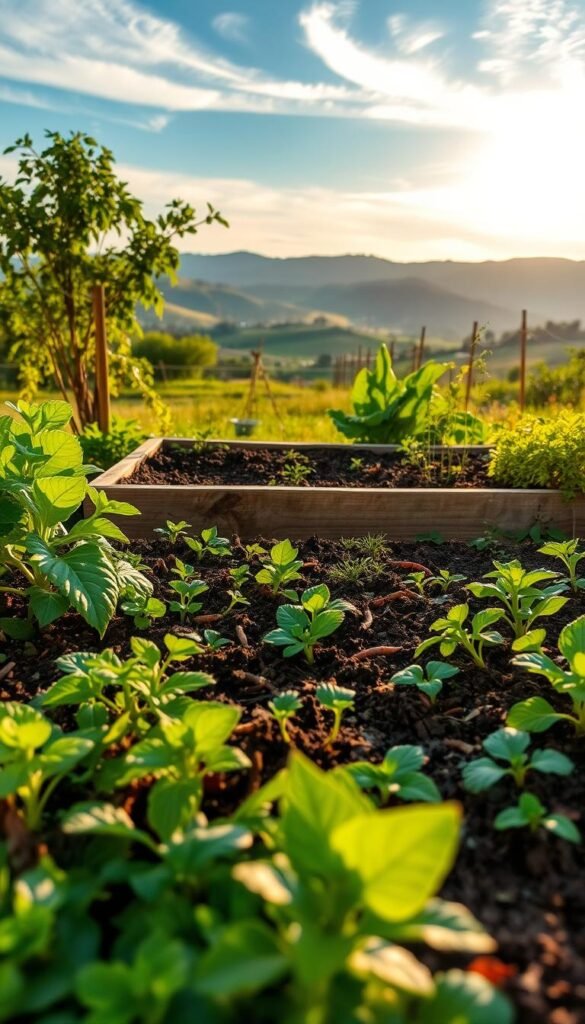
What if your garden could fight erosion and weeds while building healthier earth? Strategic use of organic materials creates a self-sustaining system that protects your plot year-round. Let’s explore nature-approved methods to shield your soil and outsmart unwanted plants.
Natural Weed Suppression Techniques
Thick mulch layers starve weeds of light, stopping 90% of seeds from sprouting according to Iowa State research. A 3-inch blanket of straw or wood chips blocks invaders better than weekly hoeing. For stubborn patches, try newspaper under mulch – it decomposes while smothering growth.
IPCC studies show organic matter in mulch feeds earthworms that naturally aerate soil. These wriggly allies disrupt weed roots while improving water absorption. You’ll spend less time pulling and more time harvesting.
Strategies to Prevent Soil Erosion
Heavy rains wash away unprotected dirt, but mulched gardens retain soil 4x longer. University trials prove shredded leaves reduce runoff by 72% compared to bare ground. Slope your beds? Lay mulch in contour lines to slow water flow.
Mix coarse materials like bark with finer compost. This combo creates a stable surface that resists wind and water damage. For steep areas, combine mulch with native plants from productive garden makeovers – their roots anchor soil naturally.
Refresh mulch every season to maintain protection. Rotate between grass clippings and leaf mold to improve soil structure while preventing compaction. Your garden becomes a fortress against erosion, one organic layer at a time.
Optimizing Mulch Application Techniques
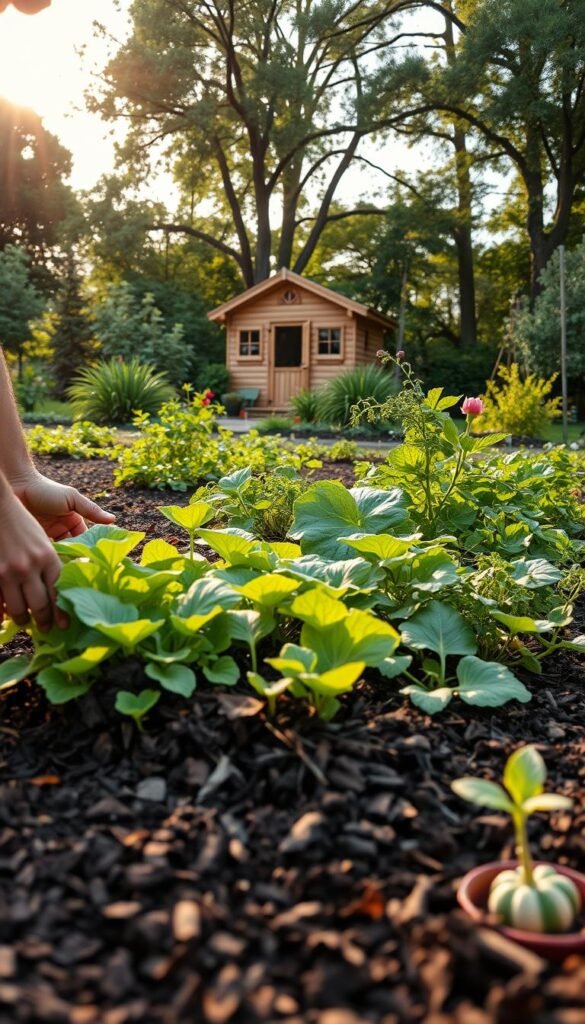
Mastering mulch application requires precision – too little won’t protect, too much can harm. Horticultural experts recommend starting with clean soil and established plants. A well-timed layer works like a thermostat for roots, balancing temperature and moisture year-round.
Proper Layering and Timing of Application
Spread organic materials in 2-3 inch layers, leaving space around plant stems. This depth retains moisture without blocking air. For annual beds, apply after seedlings reach 4 inches tall. Perennials benefit from early spring application once frost risks pass.
Use straw mulch between vegetable rows – its hollow stems create insulation. Wood chips work best around shrubs where decomposition happens slowly. Always apply thin layers of grass clippings (½ inch max) to prevent matting.
Seasonal Adjustments for Maximum Efficiency
Spring calls for lightweight materials like shredded leaves to warm soil faster. Switch to straw or bark in summer for heat protection. Autumn? Add compost before winter mulching to nourish soil microbes.
Refresh layers every 8 weeks during peak growth. In rainy seasons, reduce thickness to 1.5 inches for better drainage. Avoid fresh wood chips near nitrogen-loving plants – they temporarily lock soil nutrients during decomposition.
- Summer: Use straw to reflect heat from tomato roots
- Fall: Mix compost with leaves for winter prep
- Spring: Apply grass clippings after second mowing
DIY Tips for Using Organic Materials Effectively
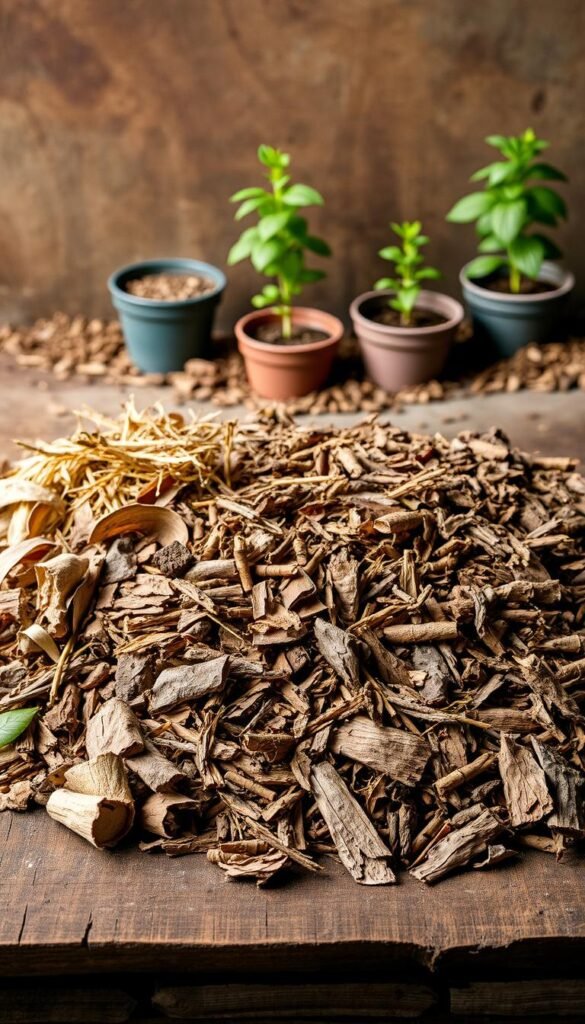
Your backyard holds hidden treasures that can supercharge garden health. With simple techniques, everyday yard waste becomes premium plant food. Let’s turn those grass clippings and fallen leaves into gold for your soil.
Repurposing Yard Waste into Nutrient-Rich Mulch
Grass clippings make fantastic nitrogen boosters when used fresh. Spread them thinly around tomatoes or peppers – they’ll release nutrients as they break down. Gardening expert Monty Don recommends mixing clippings with shredded leaves to prevent matting.
Fallen leaves transform into “black gold” leaf mold in 6-12 months. Pile them in wire bins or garbage bags with air holes. University studies show this free resource improves soil structure better than store-bought amendments.
| Material | Best Use | Key Benefit |
|---|---|---|
| Fresh grass clippings | Vegetable beds | Quick nitrogen release |
| Shredded leaves | Perennial borders | Long-term moisture retention |
| Coffee grounds | Acid-loving plants | Repels slugs |
| Shredded bark | Pathways | Weed suppression |
Enhancing Soil Structure Through Natural Additives
Create custom blends using free resources. Try this recipe: 2 parts leaves, 1 part grass clippings, and a handful of crushed eggshells. The combo adds calcium while improving drainage.
For heavy clay soil, mix in pine needles. Their acidity helps break up compacted earth. Sandy soil? Add coffee grounds – they’ll help retain moisture near plant roots.
Rotate materials seasonally. Use fresh clippings in spring for growth spurts, then switch to wood chips in summer for insulation. Your soil stays lively year-round without costly inputs.
Integrating Mulching with Sustainable Irrigation Practices
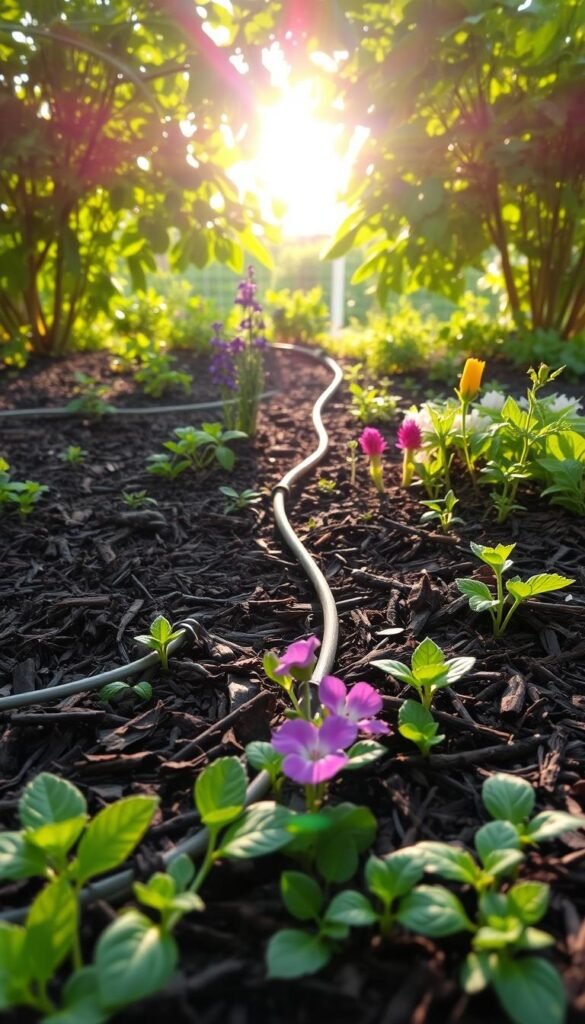
Imagine cutting your watering time in half while keeping plants lush. Combining organic ground covers with smart irrigation creates a powerhouse duo for urban growers. These methods work together to lock in hydration and prevent waste.
How Organic Layers Boost Hydration
Wood chips reduce evaporation by 40% when paired with drip systems, per University of California studies. Their porous structure acts like a sponge, slowly releasing water to plant roots. This combo keeps soil moisture steady for days, even in 90°F heat.
Grass clippings offer double duty in vegetable plots. They suppress weeds while releasing nitrogen during decomposition. Spread them 1-inch thick around peppers or eggplants for maximum effect.
Tech Meets Nature in Water Management
Modern moisture sensors reveal a key truth: mulched gardens need 35% less watering. Pair these tools with timed drip lines for precision hydration. Your tomatoes get exactly what they need – no more, no less.
Try this summer schedule for small spaces:
- Water at 6 AM before heat hits
- Check soil moisture weekly with a finger test
- Refresh mulch every 6 weeks
| Material | Best Irrigation Pair | Water Savings |
|---|---|---|
| Wood chips | Drip lines | 40% |
| Grass clippings | Soaker hoses | 32% |
| Straw | Olla pots | 28% |
| Shredded leaves | Spray nozzles | 25% |
Portland community gardens saw 50% lower water bills after adopting these strategies. Your balcony herbs or patio tomatoes can achieve similar results. Less time hauling watering cans means more time enjoying your green oasis.
Wrapping Up Your Eco-Friendly Mulching Journey
Your garden’s transformation begins beneath the surface. Layering organic materials like wood chips and straw creates a thriving ecosystem that conserves water and fights weeds naturally. Studies show these practices reduce watering needs by 35% while boosting plant vitality.
Mix materials for maximum impact. Combine grass clippings with fallen leaves to feed soil microbes, or try compost between vegetable rows for slow-release nutrition. Urban growers report 40% higher yields using blended approaches.
Healthy soil means resilient plants. Proper layering protects against erosion and temperature swings while building long-term fertility. Pair these techniques with drip irrigation for gardens that flourish with minimal effort.
Ready to see the difference? Start small with a 2-inch layer of shredded bark around tomatoes or herbs. Track changes in moisture retention and weed pressure over weeks. Your green space will thank you – one nutrient-rich harvest at a time.

